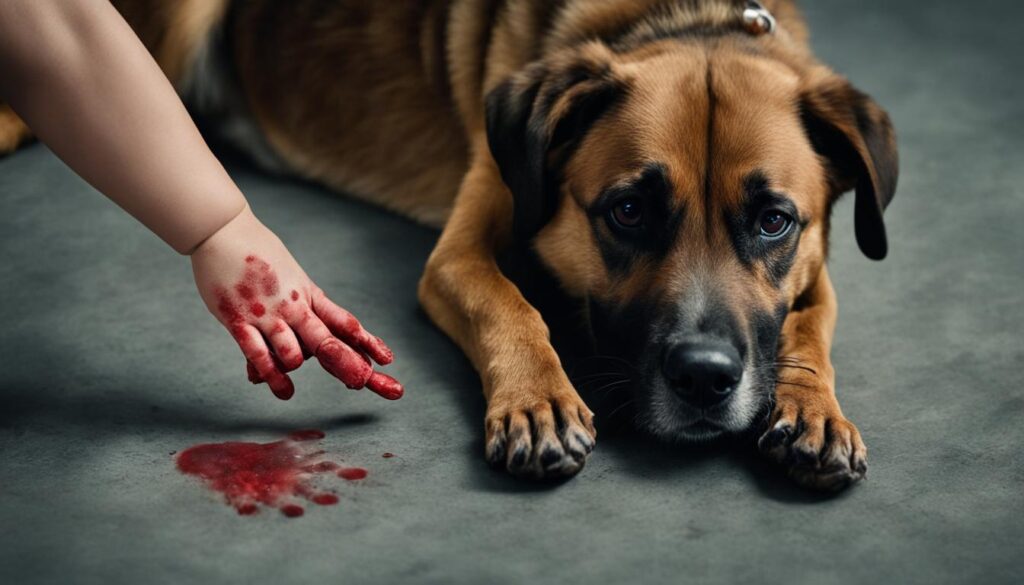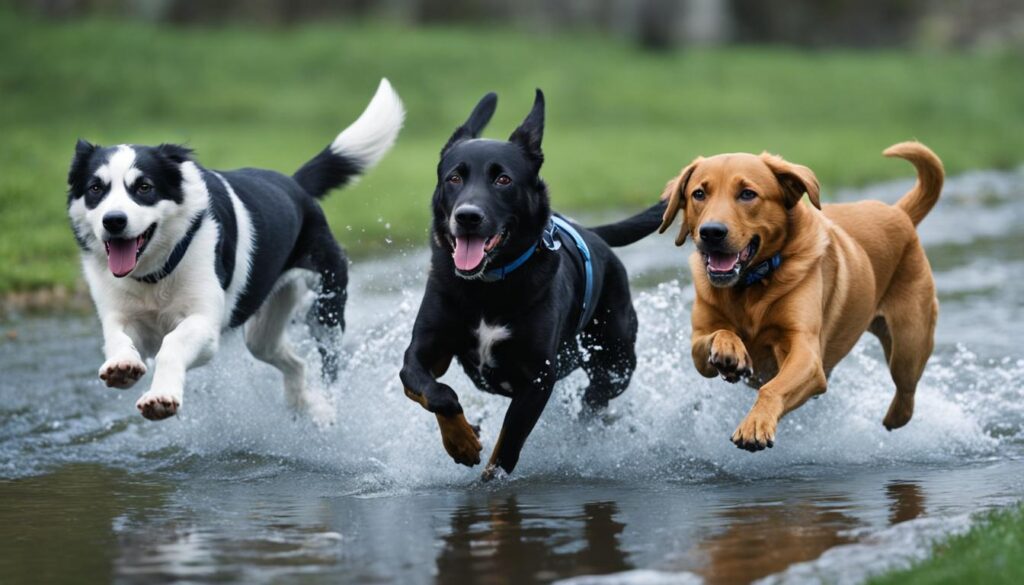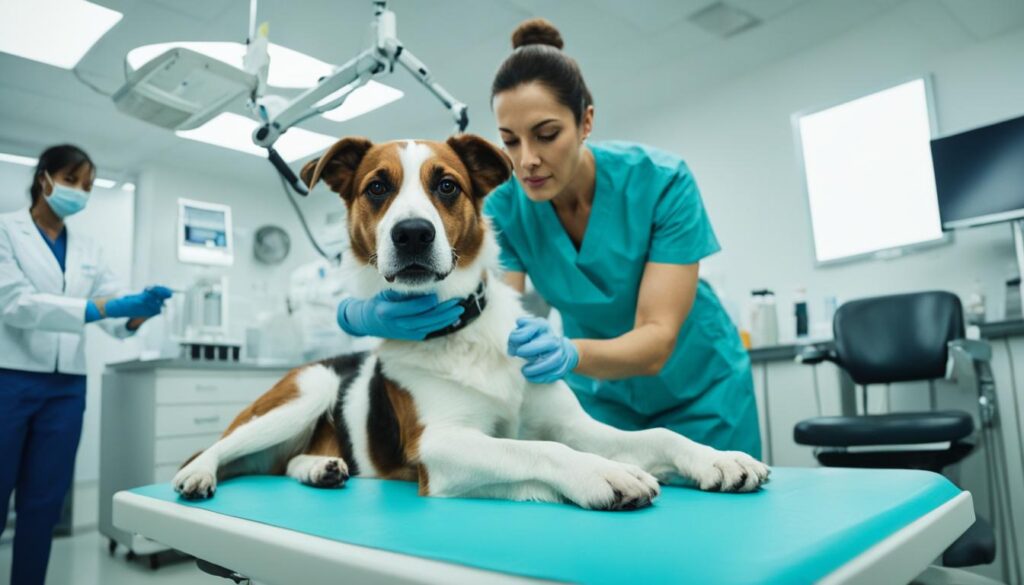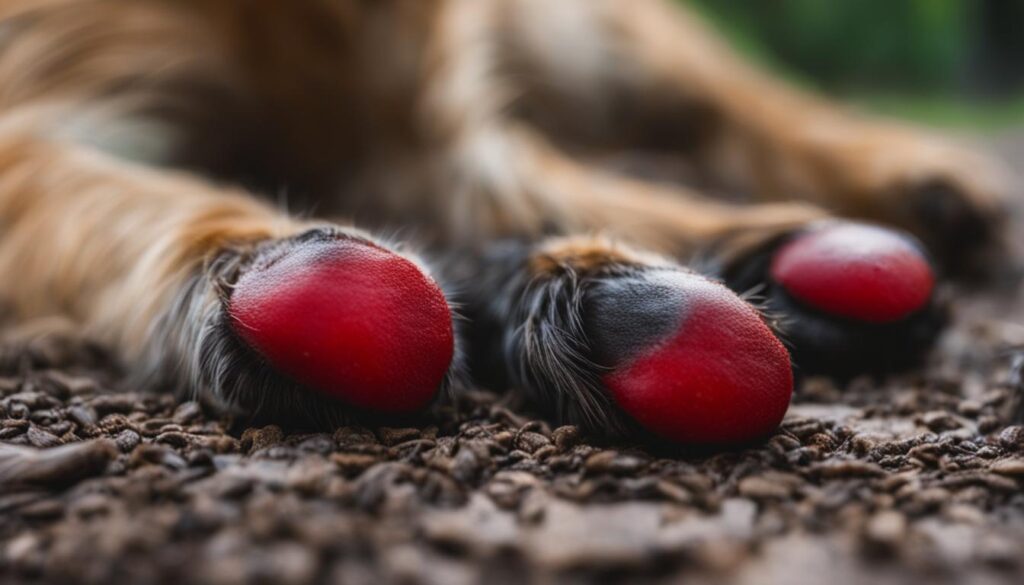Hand Foot and Mouth Disease (HFMD) is a highly contagious illness that primarily affects children. It is caused by a different virus than the one that affects animals, including dogs. Therefore, dogs cannot contract hand foot and mouth disease. However, dogs can serve as carriers of the virus and potentially spread it to other animals or humans. It is crucial to take precautions to prevent the transmission of the virus from humans to dogs and vice versa.
Key Takeaways:
- Dogs cannot get hand foot and mouth disease.
- Dogs can be carriers of the virus and spread it to others.
- Precautions should be taken to prevent transmission between humans and dogs.
- Good hygiene practices are essential to minimize the risk of spreading the virus.
- Regular vet check-ups can help ensure your dog’s overall health and well-being.
Can Dogs Transmit Hand Foot And Mouth Disease?
While dogs cannot contract hand foot and mouth disease, they can carry the virus and potentially transmit it to humans. Dogs can become carriers of the virus if they come into contact with an infected person or contaminated surfaces. It is important to practice good hygiene to prevent the spread of the virus from dogs to humans.
Dogs can potentially spread hand foot and mouth disease through direct contact with an infected person’s saliva, mucus, or blister fluid. Therefore, it is essential to wash hands thoroughly after contact with a dog or any potentially contaminated surfaces.
In order to protect both dogs and humans from the transmission of hand foot and mouth disease, it is recommended to:
- Wash hands with soap and water for at least 20 seconds after handling a dog or coming into contact with a potentially contaminated surface.
- Avoid close contact between dogs and individuals who have hand foot and mouth disease.
- Clean and disinfect surfaces that may be contaminated with the virus.
Symptoms Of Hand Foot And Mouth In Dogs

Hand foot and mouth disease is primarily a human illness and does not affect dogs in the same way. Therefore, dogs do not exhibit the symptoms commonly associated with the illness. However, it is important to note that dogs can become carriers of the virus without showing any signs of infection themselves.
If a dog becomes a carrier of the hand foot and mouth virus, they may not display any symptoms but can potentially spread the virus to other animals or humans through close contact or contaminated surfaces. This transmission can occur if the dog comes into contact with an infected person or items contaminated with the virus.
To prevent the transmission of hand foot and mouth disease, it is crucial to be aware of the possibility that dogs can carry the virus. Taking necessary precautions, such as practicing good hygiene and preventing close contact between dogs and infected individuals, can help minimize the risk of transmission.
While dogs may not experience symptoms themselves, they can contribute to the spread of the virus. Therefore, it is essential to stay vigilant and prioritize preventive measures to protect both dogs and humans from hand foot and mouth disease.
Note: The image above depicts the symptoms of Hand Foot And Mouth In Dogs. Please consult with a veterinarian for an accurate diagnosis and treatment.
Transmission Of Hand Foot And Mouth To Dogs

Dogs can potentially be exposed to the hand foot and mouth virus if they come into contact with an infected human. The virus can be transmitted through direct contact with saliva, mucus, or blister fluid from an infected person. It is important to practice good hygiene and prevent close contact between dogs and individuals who have hand foot and mouth disease.
During an outbreak of hand foot and mouth disease, it is crucial to take precautions to protect dogs and prevent the transmission of the virus. Here are some key points to keep in mind:
- Limit close contact: Avoid allowing dogs to come into direct contact with individuals who have hand foot and mouth disease. This includes avoiding close interactions, such as hugging or kissing, and maintaining a safe distance.
- Practice good hygiene: Wash your hands thoroughly with soap and water before and after handling a dog, especially if you have been in contact with an infected person. This will help minimize the risk of transmission.
- Avoid sharing personal items: Do not share personal items, such as bedding, toys, or food/water bowls, between dogs and individuals who have hand foot and mouth disease. This will help prevent potential contamination.
It is important to note that while dogs can potentially be exposed to the hand foot and mouth virus, they cannot develop the disease themselves. They can only act as carriers and transmit the virus to other animals or humans.
By taking these preventive measures, you can minimize the risk of transmission and protect both dogs and humans from the hand foot and mouth virus.
| Preventive Measures for Dogs | Benefits |
|---|---|
| Limit close contact | Reduces the risk of transmission |
| Practice good hygiene | Minimizes the spread of the virus |
| Avoid sharing personal items | Prevents potential contamination |
Prevention Of Hand Foot And Mouth In Dogs

To protect your furry companions from hand foot and mouth disease, it is crucial to take preventive measures to minimize the risk of transmission. By practicing good hygiene and avoiding close contact with infected individuals, you can significantly reduce the chances of your dog contracting the virus.
1. Wash Hands Thoroughly
Before and after handling your dog, especially if you have hand foot and mouth disease, make sure to wash your hands thoroughly. Use soap and warm water, and scrub your hands for at least 20 seconds to eliminate any potential viruses or bacteria.
2. Avoid Close Contact
Avoid allowing your dog to come into close contact with individuals who have hand foot and mouth disease. This includes refraining from petting or allowing your dog to lick infected individuals. By maintaining distance, you can minimize the risk of transmission.
3. Keep Surfaces Clean
Clean and disinfect surfaces that your dog frequently comes in contact with, such as their bedding, toys, and food/water bowls. This helps eliminate any potential traces of the virus and reduces the risk of transmission.
4. Practice Safe Socializing
When socializing your dog, choose environments where the risk of hand foot and mouth disease transmission is low. Avoid crowded places or areas where there have been reported outbreaks. Additionally, ensure that other dogs and their owners follow proper hygiene practices to minimize the spread of the virus.
5. Regularly Monitor Your Dog’s Health
Keep a close eye on your dog’s overall health and behavior. If you suspect any signs of illness, consult with your veterinarian promptly. While dogs cannot contract hand foot and mouth disease, they can still develop other conditions that may require medical attention.
By following these preventive measures, you can help safeguard your dog against hand foot and mouth disease. Taking these precautions not only protects your beloved pet but also contributes to the overall well-being of your family and community.
Treatment For Hand Foot And Mouth In Dogs

When it comes to the treatment of hand foot and mouth disease in dogs, it is important to note that dogs cannot contract the illness themselves. Therefore, there is no specific treatment or medication available for dogs with hand foot and mouth disease. However, if a dog becomes a carrier of the virus, it is crucial to manage the spread of the illness to other animals or humans.
Managing hand foot and mouth in dogs involves practicing good hygiene and taking necessary precautions. Here are some steps you can take to prevent the transmission of the virus:
- Ensure proper hand hygiene by washing your hands thoroughly with soap and water after handling a dog or coming into contact with potentially contaminated surfaces.
- Limit close contact between dogs and individuals with hand foot and mouth disease to minimize the risk of transmission.
- Regularly clean and disinfect surfaces that may come into contact with the virus, such as toys, bedding, and food/water bowls.
- Monitor the health of your dog and seek veterinary advice if you notice any signs of illness or infection.
By following these preventive measures, you can effectively manage hand foot and mouth in dogs and reduce the risk of transmission to other animals or humans.
It is important to remember that although dogs cannot contract hand foot and mouth disease, they can still carry the virus and potentially spread it. Therefore, it is crucial to take the necessary steps to protect both your dog and others from the transmission of the hand foot and mouth virus.
Hand Foot And Mouth Virus In Dogs

Dogs can become carriers of the hand foot and mouth virus if they come into contact with an infected person or contaminated surfaces. As carriers, they may not show any signs of infection themselves but can potentially spread the virus to other animals or humans. It is important to be aware of this possibility and take necessary precautions to prevent transmission.
Precautions to Prevent Transmission
- Minimize direct contact between dogs and individuals with hand foot and mouth disease.
- Encourage regular handwashing before and after handling dogs, especially if you have been in contact with someone with the virus.
- Clean and disinfect surfaces that may have been contaminated with the virus.
- Keep dogs away from areas where there is a known outbreak of hand foot and mouth disease.
By following these precautions, you can help protect your dog and prevent the spread of the hand foot and mouth virus. It is always important to prioritize the health and well-being of both humans and animals.
| Canine Carriers of Hand Foot and Mouth | Precautions to Prevent Transmission |
|---|---|
| Dogs can become carriers of the hand foot and mouth virus. | Minimize direct contact between dogs and infected individuals. |
| Carriers may not show any signs of infection. | Encourage regular handwashing before and after handling dogs. |
| Dogs can potentially spread the virus to other animals or humans. | Clean and disinfect surfaces that may have been contaminated. |
| Preventing transmission is essential to protect the health of all individuals. | Keep dogs away from areas with a known outbreak of hand foot and mouth disease. |
Hand Foot And Mouth Outbreak In Dogs

Hand foot and mouth disease primarily affects children and is not commonly found in dogs. Therefore, outbreaks of hand foot and mouth specifically in dogs are rare. However, dogs can become carriers of the virus and potentially contribute to the spread of the illness if they come into contact with infected individuals or contaminated surfaces.
Preventing the Spread
While dogs may not develop symptoms of hand foot and mouth disease, they can still carry and transmit the virus to other animals or humans. It is crucial to take precautions to prevent the spread of the disease and protect both dogs and humans. Here are some steps that can help:
- Practice good hygiene: Regularly wash your hands with soap and water, especially after contact with dogs or potentially contaminated surfaces.
- Isolate infected dogs: If a dog is known to be a carrier of the hand foot and mouth virus, keep them separated from other animals and humans to minimize the risk of transmission.
- Clean and disinfect: Thoroughly clean and disinfect any areas or objects that may have come into contact with the virus, such as dog toys, bedding, and food/water bowls.
- Avoid close contact: Minimize close contact between infected individuals and dogs to reduce the chances of transmission.
- Seek veterinary advice: If you suspect that your dog may have been exposed to hand foot and mouth disease or if you have any concerns, consult with your veterinarian for guidance and appropriate preventive measures.
By following these preventive measures, you can help minimize the risk of hand foot and mouth outbreaks in dogs and keep them safe and healthy.
Protecting Dogs From Hand Foot And Mouth
To protect dogs from the hand foot and mouth virus, it is crucial to take preventive measures to prevent their exposure to infected individuals or contaminated surfaces. By practicing good hygiene and implementing proper precautions, you can safeguard your furry friend from the transmission of hand foot and mouth disease.
Here are some essential steps to protect your dog:
- Wash your hands thoroughly before and after handling your dog, especially if you or someone around you has hand foot and mouth disease. This simple act can significantly reduce the risk of transmission.
- Avoid close contact between your dog and people who have been infected with hand foot and mouth disease or contaminated surfaces linked to the virus. This will help minimize the chances of transmission.
- Regularly clean and disinfect your dog’s living environment, including their bedding, toys, and food/water bowls. This will help eliminate any potential contaminants that could spread the virus.
- Keep your dog’s hygiene in check by maintaining proper grooming and cleanliness. Regularly bathing your dog and keeping their living areas clean will contribute to their overall well-being and reduce the risk of transmission.
- Monitor the health of your dog closely. If you suspect your dog may have been exposed to the hand foot and mouth virus, consult your veterinarian immediately for guidance and appropriate preventive measures.
By adopting these preventive steps, you can significantly reduce the risk of potential transmission of the hand foot and mouth virus to your beloved dog.
| Preventive Measures | Benefits |
|---|---|
| Wash hands thoroughly before and after handling the dog | Reduces the risk of transmission |
| Avoid close contact with infected individuals or contaminated surfaces | Minimizes chances of transmission |
| Clean and disinfect dog’s living environment | Eliminates potential contaminants |
| Maintain proper grooming and cleanliness | Improves overall well-being and reduces transmission risk |
| Monitor your dog’s health closely | Early detection and appropriate preventive measures |
Can Dogs Get MRSA?
Dogs, like humans, can contract Methicillin-Resistant Staphylococcus Aureus (MRSA), a drug-resistant bacterial infection. MRSA infections in dogs are more common in healthcare settings or among animals that have been in close contact with infected humans. It is crucial to take precautions to prevent the transmission of MRSA between humans and dogs, as well as between dogs themselves.
MRSA in dogs can be a serious health concern, as it is difficult to treat and can cause various complications. It is essential for dog owners and veterinary professionals to be aware of the signs and symptoms of MRSA in dogs and take appropriate measures to prevent its spread.
Symptoms of MRSA in Dogs
While the symptoms of MRSA in dogs may vary, some common signs to watch out for include:
- Skin infections, such as abscesses or boils
- Open sores or wounds that do not heal
- Pain or discomfort
- Inflammation or swelling
- Lethargy or decreased appetite
If you notice any of these symptoms in your dog, it is important to seek veterinary care promptly. Early detection and treatment can help prevent the spread of the infection and improve the chances of a successful outcome.
Transmission of MRSA to Dogs
Dogs can become infected with MRSA through close contact with infected humans or other animals. The bacteria can be transmitted through direct contact with infected wounds, skin, or bodily fluids. Additionally, contaminated objects or surfaces can also serve as a source of transmission. Pet owners who have MRSA should take precautions to prevent the spread of the bacteria to their dogs.
Preventing MRSA in Dogs
To protect your dog from MRSA, follow these preventive measures:
- Practice good hygiene: Wash your hands thoroughly before and after handling your dog, especially if you have MRSA or open wounds.
- Keep wounds clean and covered: If your dog has a wound, ensure it is properly cleaned and dressed to prevent infection.
- Avoid sharing personal items: Do not share items such as towels, bedding, or grooming tools between humans and dogs.
- Regular veterinary check-ups: Schedule regular veterinary visits for your dog to monitor their overall health and detect any potential infections early.
By implementing these preventive measures, you can help reduce the risk of MRSA transmission to your dog and other household pets.
Treatment for MRSA in Dogs
MRSA infections in dogs require prompt veterinary intervention. Treatment may involve a combination of antibiotics, wound care, and supportive therapy. It is crucial to follow your veterinarian’s instructions diligently to ensure the best possible outcome for your dog.
Can Dogs Transmit MRSA to Humans?
Dogs can potentially transmit Methicillin-Resistant Staphylococcus Aureus (MRSA) to humans, especially if they are carriers of the bacteria. Close contact with a dog that has MRSA or contaminated items such as bedding or food/water bowls can contribute to the spread of the bacteria. It is important to practice good hygiene and take necessary precautions to prevent the transmission of MRSA between dogs and humans.
MRSA is a drug-resistant bacterial infection that can be found in dogs. While it is more commonly associated with human healthcare settings, dogs can also contract the infection. In cases where a dog has MRSA, there is a potential risk of transmission to humans through direct contact with the dog or contaminated items.
This highlights the importance of practicing good hygiene when handling dogs, especially those that are known or suspected carriers of MRSA. Washing hands thoroughly with soap and water before and after interacting with a dog can help reduce the risk of transmission. It is also essential to keep the dog’s living environment clean and regularly sanitize items such as bedding, bowls, and toys.
Avoiding close contact with a dog that has MRSA, such as refraining from sharing bedding or allowing the dog to lick your face, can further minimize the risk of transmission. If you suspect that your dog may have MRSA or if you have been diagnosed with MRSA and have a dog, it is important to consult with a veterinarian and healthcare professional for guidance on managing the infection and taking appropriate precautions.
Preventing MRSA Transmission Between Dogs and Humans
To prevent the transmission of MRSA between dogs and humans, follow these guidelines:
- Practice good hand hygiene by washing hands thoroughly with soap and water before and after interacting with a dog, especially if the dog has MRSA.
- Keep the dog’s living environment clean and regularly sanitize items such as bedding, bowls, and toys.
- Avoid close contact with a dog that has MRSA, such as refraining from sharing bedding or allowing the dog to lick your face.
- If you suspect that your dog may have MRSA or if you have been diagnosed with MRSA and have a dog, consult with a veterinarian and healthcare professional for guidance on managing the infection and taking appropriate precautions.
By following these preventive measures, you can help reduce the risk of MRSA transmission between dogs and humans, safeguarding the health and well-being of both.
Wrapping Up
Hand foot and mouth disease is not a condition that dogs can contract, but they can become carriers of the virus and potentially transmit it to other animals or humans. It is important to be aware of the potential for transmission and take necessary precautions to prevent the spread of the virus.
One crucial step in preventing transmission is practicing good hygiene. This includes washing hands thoroughly after contact with a dog or any potentially contaminated surfaces. By maintaining proper hygiene, we can minimize the risk of spreading the hand foot and mouth virus between dogs and humans.
In addition to hand foot and mouth disease, dogs can contract MRSA, a drug-resistant bacterial infection. Just like with hand foot and mouth, dogs can potentially transmit MRSA to humans. To minimize the risk of MRSA transmission, it is crucial to practice proper hygiene and take preventive measures.
By understanding the risks associated with these conditions and implementing appropriate precautions, we can protect both ourselves and our furry friends. Remember to always prioritize good hygiene and take necessary steps to prevent the transmission of hand foot and mouth disease and MRSA between dogs and humans.
FAQ
Can dogs get hand foot and mouth disease?
Hand foot and mouth disease is a highly infectious disease that primarily affects children. Dogs cannot contract hand foot and mouth disease, but they can become carriers of the virus and potentially spread it to humans.
Can dogs transmit hand foot and mouth disease?
Yes, dogs can transmit the hand foot and mouth virus to other animals or humans if they become carriers of the virus. It is important to practice good hygiene and prevent close contact between dogs and individuals with hand foot and mouth disease to minimize the risk of transmission.
What are the symptoms of hand foot and mouth in dogs?
Dogs cannot exhibit symptoms of hand foot and mouth disease as they cannot contract the illness. However, if they become carriers of the virus, they may not show any signs of infection themselves but can potentially spread the virus to others.
How can hand foot and mouth be transmitted to dogs?
Dogs can potentially be exposed to the hand foot and mouth virus if they come into contact with an infected human. The virus can be transmitted through direct contact with saliva, mucus, or blister fluid from an infected person.
How can I prevent hand foot and mouth in dogs?
The best way to prevent hand foot and mouth disease in dogs is to prevent the transmission of the virus from humans. This can be done by practicing good hygiene, such as washing hands thoroughly before and after handling a dog, especially if the person has hand foot and mouth disease. Minimizing close contact between dogs and infected individuals is also essential in preventing transmission.
Is there a treatment for hand foot and mouth in dogs?
Since dogs cannot contract hand foot and mouth disease, there is no specific treatment or medication for the illness in dogs. However, if a dog becomes a carrier of the virus, it is important to prevent its spread to other animals or humans by practicing good hygiene and taking necessary precautions.
Can dogs be carriers of the hand foot and mouth virus?
Yes, dogs can become carriers of the hand foot and mouth virus if they come into contact with an infected person or contaminated surfaces. As carriers, they may not show any signs of infection themselves but can potentially spread the virus to other animals or humans.
Are there hand foot and mouth outbreaks in dogs?
Hand foot and mouth disease primarily affects children and is not commonly found in dogs. Therefore, outbreaks of hand foot and mouth specifically in dogs are rare. However, dogs can become carriers of the virus and potentially contribute to the spread of the illness if they come into contact with infected individuals or contaminated surfaces.
How can I protect my dog from hand foot and mouth disease?
To protect dogs from the hand foot and mouth virus, it is important to prevent their exposure to infected individuals or contaminated surfaces. This can be done by practicing good hygiene, such as washing hands thoroughly before and after handling a dog, especially if the person has hand foot and mouth disease. Minimizing close contact between dogs and infected individuals is also essential in preventing transmission.
Can dogs get MRSA?
Yes, dogs can contract Methicillin-Resistant Staphylococcus Aureus (MRSA), a drug-resistant bacterial infection. However, MRSA infections in dogs are more likely to occur in healthcare settings or among animals that have been in close contact with infected humans.
Can dogs transmit MRSA to humans?
Dogs can potentially transmit MRSA to humans, especially if they are carriers of the bacteria. Close contact with a dog that has MRSA or contaminated items such as bedding or food/water bowls can contribute to the spread of the bacteria. It is important to practice good hygiene and take necessary precautions to prevent the transmission of MRSA between dogs and humans.






